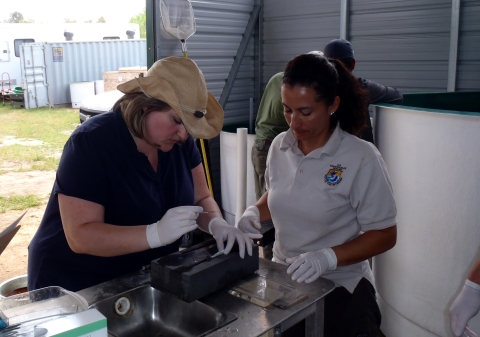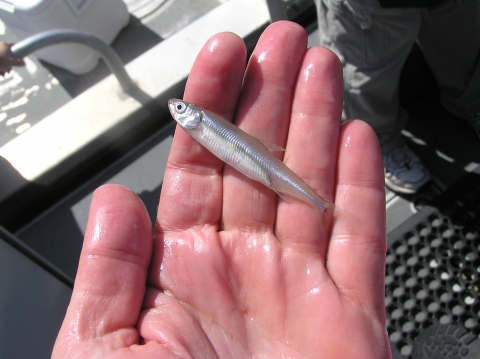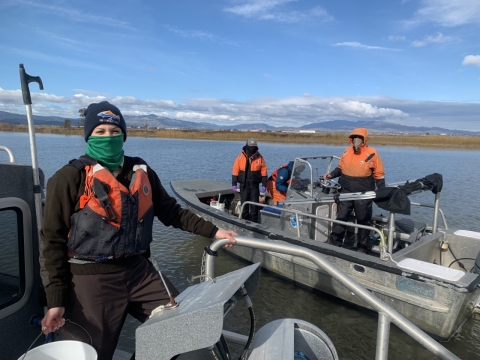Projects and Research
Delta Juvenile Fish Monitoring Program
The Lodi office's Delta Juvenile Fish Monitoring Program conducts near-daily monitoring of juvenile fishes, participates in multi-agency research activities and contributes to several technical and management committees within the region.
Enhanced Delta Smelt Monitoring Program
The Enhanced Delta Smelt Monitoring Program is a high-effort, year-round program to sample randomly selected locations throughout the San Francisco Estuary. Throughout the year, the program targets three Delta smelt life stages (larvae, juvenile and adult) using multiple gear types, and reports the data in near-real time.
San Joaquin River Restoration Program
We work with multiple agencies and partners to achieve the San Joaquin River Restoration Program's fish restoration goal of restoring naturally reproducing and self-sustaining fish populations, including Chinook salmon, to the San Joaquin River between Friant Dam and the Merced River confluence.
Anadromous Fish Restoration Program
The Anadromous Fish Restoration Program aims to at least double the natural production of anadromous fish in California's Central Valley streams on a long-term, sustainable basis. The AFRP works to achieve the doubling goal through a variety of projects throughout the Central Valley. We work cooperatively with other federal, state and local agencies, nonprofits, for-profit institutions, universities and private landowners on projects that increase available juvenile and adult salmon habitat.
Science Support Program
The Science Support Program provides statistical, modeling and synthesis support for the office and the region. Among the many activities of this group, the Delta Smelt Life Cycle Model and Juvenile Salmonid Survival Studies are just two examples. Statisticians and biologists in the Lodi and San Francisco Bay-Delta Fish and Wildlife offices have created a Delta Smelt Life-Cycle Model and a Delta Smelt Individual-Based Model to assess and predict the effects of water resource-management actions on the Delta smelt population. The team worked for years to create the models, which help scientists follow trends in fish abundance, reproduction and mortality. Their research has produced many articles in peer-reviewed journals, some of which can be accessed in this collection. Our team also participates in large-scale, multi-agency, juvenile salmonid survival studies in the Sacramento-San Joaquin River Delta. Presently we are conducting juvenile salmon and steelhead survival studies in the south Delta.
Aquatic Invasive Species
We provide technical assistance to people, programs and watershed groups by monitoring the spread of non-native plants and animals. Our goal is to protect and restore healthy, native ecosystems by providing decision support and guidance to our partners working to prevent, manage and mitigate the impacts of non-native species like Chinese mystery snail, bluefin killifish, weather loach and various aquatic vegetation. For more information, see the Service's aquatic invasive speciespage.
Smelt Monitoring Team
The Smelt Monitoring Team reviews a variety of real-time data to assess the risk that longfin smelt and threatened Delta smelt will be trapped or diverted by water-pumping operations, also known as entrainment. The Smelt Monitoring Team — made up of members from the Fish and Wildlife Service, the U.S. Bureau of Reclamation, California Department of Fish and Wildlife, California Department of Water Resources, State Water Resources Board and others — provides advice to the multi-agency Water Operations Management Team to help guide real-time management of operations.
CVPIA Science Integration Team
The CVPIA Science Integration Team is a key effort of the Service and the Bureau of Reclamation to continuously improve collaboration between the two agencies and other stakeholders under a science-based framework that is both transparent and efficient. Our recommendations guide efforts toward the Central Valley Project Improvement Act’s goal of doubling the natural production of Chinook salmon and other anadromous fish from pre-act levels in the Central Valley.
Interagency Ecological Program
The Interagency Ecological Program is a collaboration of six federal agencies and three state of California departments, which have been conducting ecological investigations together since the 1970s. The IEP supports coordination of monitoring, research, modeling and synthesis efforts that aid the management of the Bay-Delta ecosystem and the water that flows through it.
Watershed Stewards Program
Through the Watershed Stewards Program, we collaborate with the California Conservation Corps and AmeriCorps to improve watershed health. The Lodi office hosts and mentors members of the program, whose primary focus is to assist communities and organizations with habitat restoration for threatened and endangered fish species. The program assists with data collection and analysis, restoration-project development and maintenance, and educational outreach.







